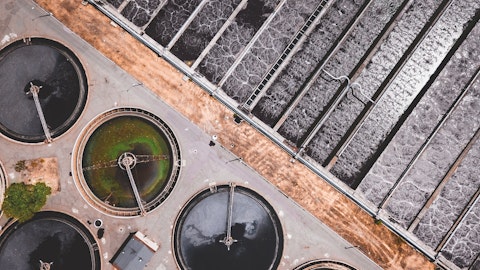Kurt Bitting: Yes. Well, I think the first is the sulfur pricing is related to sulfur pricing. So we did see a step-up in sulfur pricing which we passed through to our customers at a 100% level, so that will — pricing will rise on the basis of that raw material cost pass-through. But then we have a high amount of contracts. A high amount of our business is also contracted. So we don’t have a tremendous amount of material that’s changing office long-term price contract at any given point, most of it around 90%-ish is under a longer-term 1, 2, 3 or even 5-year contract.
Unidentified Analyst: Okay. And then — and just last one for me. As we go into ’24, there’s a lot of uncertainty just in the global macro environment. Can you just remind us, how should we think about the underlying earnings power of this business in a lower growth economic environment or potential recessionary environment?
Kurt Bitting: Yes. So we’ve — a bunch of us, Mike and the management team and myself have been with the business for quite some time and seen the business go through a couple of cycles. And we feel the business as a whole, due to its diverse end market uses that it services is — sets up well and is pretty resilient through economic down cycles. I’ll point you to the regeneration business which is largely linked to refinery utilization, the value of octane. All those things look positive going into next year and generally not all that cyclical with other economic macroeconomic headwinds. Mining, another large segment for us. Obviously, with all the demand for metals and minerals going forward for electrification and green infrastructure should remain firm.
Our treatment services and activation business are also largely in a very sold-out position and we would expect that to continue. And then finally, the renewables space continues to grow, right? As renewable fuels become a more — gain a larger share of the overall distillate pool moving from eventually up to 5% by 2025. That production level is going to continue to grow and that should continue to happen in light of any macroeconomic headwinds.
Operator: Our next question comes from Patrick Cunningham, Citi.
Unidentified Analyst: This is Eric [ph] on for Patrick. With the anticipated stronger sales in hydrocracking catalyst in 1Q ’24, what sort of uplift should we see there? And how should we think about the margin profile for Catalyst Technologies as a whole?
Kurt Bitting: So I would say, Eric. It’s clearly, what I’d say about hydrocracking is we’re in that 6-month period of really high concentration of sales between what we expect to realize in Q4 and then what we see in the pipeline for Q1. We’re really not in a position to guide, really, for the full year of 2024 for hydrocracking because we just don’t have that full year visibility on the order pipeline yet. And the order timing for that can change, right, in terms of the cadence of orders, it has changed a little bit since we’ve come out of the pandemic. There used to be much more predictability but the pandemic kind of stretched some turnarounds, product mix has changed at refineries. So we don’t quite have that visibility yet.
That being said, I would not expect a peak or a high concentration cycle that we’ve had during this 6-month period that we think we’re going to have to repeat itself sometime later in ’24. I mean, it’s clearly a high concentration cycle right now.
Unidentified Analyst: Okay. Got it. And my last question is what is driving the balance in backlog to build ratio for emission control catalysts?
Kurt Bitting: I mean, the backlog in that segment is really a hangover of just tremendous shortage and that sort of thing that went on for heavy-duty vehicle, right? So there was a period during the pandemic. And coming out of the pandemic, there was a high demand for trucks. So they’re still working through that order backlog, similar to what’s going on in the auto industry. So it just really hang over the backlog of the whole chip and supply chain shortage that was experienced in ’21 and ’22.
Operator: Next question comes from Hamed Khorsand, BWS Financial.
Hamed Khorsand: So first off, just on the SG&A line. How sustainable is that as far as what you reported in Q3 and going forward? And was there any special savings there that occurred?
Michael Feehan: Yes. I think the SG&A was a little bit lower, really because of some employment compensation adjustment in there. So it’s probably a little more beneficial than other quarters.
Hamed Khorsand: By — can you provide some like magnitude? I mean, there was quite a bit of a drop from Q2 levels.
Michael Feehan: Yes. I mean there’s a couple of million dollars were flowing through there that would probably not be recurring in future quarters.
Hamed Khorsand: And my other question was, your commentary around hydrocracking in Q1, how would that impact your nameplate capacity for all of ’24 and your contracts that you usually enter into for ’24?
Kurt Bitting: Hamed, it doesn’t impact our ability to service the customers going into 2024. I think the material impact that it’s had, what Mike was mentioning on the call was, we have a big — a large inventory build right now going on to meet those orders in Q1 which Q1 is a heavier quarter and across that span of that 6-month period, there’s a high concentration of volume and sales going out. So — but our production assets have the capability to meet that required production schedule. So there’ll be no issue there.
Operator: Our next question comes from Laurence Alexander, Jefferies.
Daniel Rizzo: This is actually Dan Rizzo on for Laurence. Just thinking about pricing going forward. I think it’s been fairly strong but I was just given thinking just given the volatility, some of the destocking going on, what your — how you’re thinking about it in Q4 and as we head into 2024?




